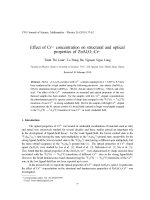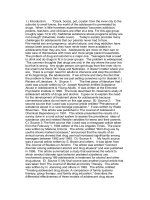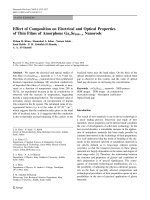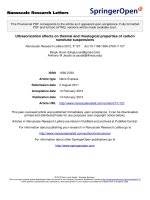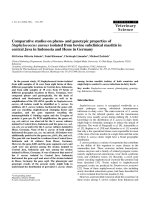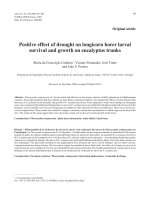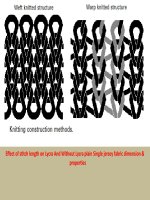Effect of ultraviolet-c treatment on enzymes and nutritional properties of tender coconut water
Bạn đang xem bản rút gọn của tài liệu. Xem và tải ngay bản đầy đủ của tài liệu tại đây (674.86 KB, 14 trang )
Int.J.Curr.Microbiol.App.Sci (2017) 6(5): 2905-2918
International Journal of Current Microbiology and Applied Sciences
ISSN: 2319-7706 Volume 6 Number 5 (2017) pp. 2905-2918
Journal homepage:
Original Research Article
/>
Effect of Ultraviolet-C Treatment on Enzymes and Nutritional
Properties of Tender Coconut Water
Shivashankar Sanganamoni*, Soumya Purohit and P. Srinivasa Rao
Agricultural and Food Engineering Department
Indian Institute of Technology, Kharagpur – 721 302, West Bengal, India
*Corresponding author
ABSTRACT
Keywords
Tender coconut
water, Ultraviolet
treatment, PPO,
POD, Total phenols
Article Info
Accepted:
26 April 2017
Available Online:
10 May 2017
The effect of ultraviolet (UV-C) treatment on enzymes (viz. Polyphenol oxidase and
Peroxidase) and nutritional properties (viz. Ascorbic acid, Antioxidant activity and Total
phenolic content) of tender coconut water (Cocos nucifera) were studied during this
research work. The process conditions for ultraviolet treatment were sample thickness (1,
2, 3 mm), treatment time (30, 60, 90 min) and distance of sample from lamp source (8.6,
13.7, 18.6 cm).The results obtained from this study showed that the UV- C treatment
conditions had significant effect (p< 0.0001) on ascorbic acid, total phenolic content,
antioxidant capacity, PPO and POD of TCW. The maximum inactivation of PPO was
achieved to be 51.5% in ultraviolet treatment, and the maximum inactivation of POD in
ultraviolet treatment was65.7%. The obtained results evident, that the PPO was most
resistant enzyme to UV light. Further, the results were compared with the thermal
treatment of tender coconut water which is conducted as a part of this experiment and
observed that, maximum inactivation of PPO and POD was achieved in thermal treatment
than ultraviolet treatment. In contrast, the deterioration of nutritional properties in thermal
treatment was high as compared to ultraviolet treatment. The obtained results suggested
that, although the thermal treatment was better processing option pertaining to enzyme
inactivation, but ultraviolet treatment was found superior based on retention of nutritional
attributes.
Introduction
Coconut (Cocos nucifera L.) is perennial plant
that flowers year round and belongs to the
family of the “Arecaceae”. Coconut is
important fruit tree that provides food for
millions of peoples and with its many uses it
is popularly known as “Tree of Life” (Chan et
al., 2006).
The edible part of coconut fruit (coconut meat
and water) is the endosperm tissue.
Endosperm tissue undergoes one of three
main modes of development namely nuclear,
cellular, helobial (Lopes et al., 1993). Inside
each coconut‟s outer shell is a white meaty
layer, and inside that is the central cavity
(Gabriel, 2009). This central cavity is coated
with a jelly-like substance. This jelly is
translucent and very soft when the coconut is
young (Jackson et al., 2004). The cavity is
filled up with a liquid endosperm, which is
cytoplasmic in origin (Yong et al., 2009).
This cavity can be filled with up to 600ml of
liquid (Chowdhury et al., 2005). Yong et al.,
(2009) stated that the liquid part of the
2905
Int.J.Curr.Microbiol.App.Sci (2017) 6(5): 2905-2918
coconut‟s endosperm is the coconut water
(CW) or coconut juice.
Coconut water is a sweet clear liquid, filled in
nut when the nut is 5 to 6 months old.
Coconut water is tropical fruit juice, highly
valued and consumed in tropical areas since it
is tasty and has desirable nutritional and
therapeutic
properties.
Indonesia,
the
Philippines, and India are the largest
producers of coconut in the world. Coconut
water has been called the “fluid of life” due to
its medicinal benefits such as oral
rehydration, treatment of childhood diarrhea,
gastroenteritis and cholera (Kuberski, 1980;
Carpenter and others 1964). It is high in
electrolyte content and has been reported as
an isotonic beverage due to its balanced
electrolytes like sodium and potassium that
help restore losses of electrolytes through skin
and urinary pathways. Coconut water was
claimed as a natural contender in the sports
drink market with its delicate aroma, taste and
nutritional characteristics together with the
functional characteristics required in a sports
drink [Food and Agricultural Organization
(FAO) 2005].
Generally, the tender coconut water present
inside the fruit is shelf sterile and stable for
few days (Yong et al., 2009), but shelf life of
extracted tender coconut water is very less.
The spoilage of extracted TCW mainly due to
the presence of enzymes, belonging to
oxidase family (Polyphenol oxidase and
Peroxidase), that in contact with atmospheric
oxygen. The oxidative enzymes have high
thermal resistance and their activity leads to
yellow, brown or even pink colouring during
storage, even under refrigeration.
Polyphenol oxidase (PPO) and Peroxidase
(POD) are widely detected in many fruits and
vegetables and are closely linked to
enzymatic color changes with consequently
loose on sensorial properties (Campos et al.,
1996). According to some food technologists,
Polyphenol oxidase is indirectly responsible
for fruit and vegetables enzymatic browning,
it catalyzes two types of oxidative reactions.
Such as hydroxylation of monophenols to odiphenols, and the oxidation of this last one
colorless compound to highly colored oquinones.
Presently thermal treatment is most
commonly applied for inactivating enzymes
in coconut water. But the thermal treatment
leads to destruction of heat sensitive nutrients
which restricts its application for processing
of coconut water. Besides the loss of
nutrients, it also shows a detrimental effect on
color and flavor.
Alternative methods are high pressure
application, pulsed electric field, irradiation,
and aseptic packaging. However, there are
some disadvantages of these techniques in
terms of cost, loss of ascorbic and some other
quality attributes.
Considering these limitations of other
techniques, UV-Cradiation can be used as an
alternative method for processing and
preservation of TCW. This process does not
produce chemical residues (Canitez, 2002).
Besides, it is a low-cost operation and
effective against many microorganisms
(Bintsis et al., 2000) and enzymes.
UV Light is the part of electromagnetic
spectrum with wave lengths ranges from 100 400 nm. UV light is traditionally subdivided
into three categories (viz. UV-A, UV-B and
UV-C). UV-C is used for surface disinfection
of different fruits and other processing
equipment. Application of UV light on
various liquid foods like apple cider, orange
juice, grape juice, milk and honey have been
reported recently. Germicidal properties UVC is due to the absorption of the UV-light by
DNA, which causes formation of thymine
2906
Int.J.Curr.Microbiol.App.Sci (2017) 6(5): 2905-2918
dimer in the same DNA strand (Miller et al.,
1999). Due to this, the DNA transcription and
replication is blocked, which compromises
cellular functions and leads to cell death
(Miller et al., 1999). The penetration depth of
UV light in coconut water is more because of
the UV absorption coefficient of coconut
water is less, thus it facilitates UV rays to
pass through it.
By considering all above factors, the present
study was aimed to study the effect of UV-C
treatment on enzymes and nutritional
properties of tender coconut water.
Materials and Methods
Procurement of Tender Coconut Water
(TCW)
6-8 months matured tender coconut fruits of
approximately same size contained coconut
flesh (jelly like) less than 2 mm and without
any visible damage on outside were
purchased from local market at IIT
Kharagpur. Surface of coconut husk was
properly cleaned with distilled water followed
by 1% sodium hypochlorite sanitize solution
(Walter et al., 2009). After, the coconuts were
placed in laminar flow UV light chamber for
30 min to make coconuts free from surface
contamination.
Chemicals and reagents
All the chemicals and reagents used in the
study were analytical grade and procured
from Merck, India and Sigma-Aldrich,
Germany.
UV-C treatment of tender coconut water
The tender coconut water was processed
using batch type UV-C apparatus designed
and fabricated at IIT Kharagpur with proper
development. The system was designed such
a way that, the distance of sample from lamp
source can be varied. Three 18 W low
pressure mercury vapor UV lamp which emits
the UV-C light continuously in the wave
length ranges from 200-300 nm were
mounted at the top of treatment chamber.
Time of UV-C exposure was controlled using
a manually operated control switch.
Measured quantity of TCW was poured in
150 mm standard size petri plates and placed
at the center of holder platform (used for
maintain different distances between sample
and lamp source). Different thickness of
sample was maintained by changing the
quantity of sample in petri plates. To prevent
the exposure of UV light to human skin, a
cover was placed in front of the system.
Experimental design
Tender coconut water was manually extracted
from coconut fruit using free washed and
sanitized sharp stainless steel, and filtered
through muslin cloth. The filtered TCW
obtained from several fruits (4-5 coconut
fruits having same maturity level) was mixed
in a glass beaker.
The mixed TCW was filled and packed in
LDPE (low density polyethylene) pouches
and immediately stored at -18 °C before use.
Whole TCW extracted from fruit was
processed on the same day of extraction.
Full factorial design with 3 replications was
followed throughout the experiment. The
independent variables viz. Treatment time (t –
15, 30,45,60,75 and 90 min), Distance from
lamp source (H – 8.6, 13.7, 18.6 cm) and
Sample thickness (x – 1, 2, 3 cm) were
selected with three levels of each of
independent variables and their combinations
had been investigated for each attribute. After
each experiment, PPO, POD activity and
nutritional properties (Viz. Ascorbic acid,
Total phenols and antioxidant activity) were
2907
Int.J.Curr.Microbiol.App.Sci (2017) 6(5): 2905-2918
analyzed to know the effect of treatment on
its.
expressed in U.ml-1 min-1 (µg of protein)-1.
The relative activity (Arel) can be calculated
by using equation 1.
Enzyme activity measurement
Polyphenol oxidase (PPO) was determined
according to the method proposed by Tan et
al., (2014) with slight modifications. Prepare
0.2 M Sodium phosphate buffer of pH 6
[2.745 g of sodium dihydrogen phosphate dihydrate (NaH2PO4 2H2O) and 0.427 g of
disodium hydrogen phosphate di-hydrate
(Na2HPO4 2H2O) was mixed in 100 ml of
double distilled water]. 0.2M Pyrocatechol
solution (0.2 M) was used as phenol substrate
[0.55 g of pyrocatechol in 25ml 0.2 M
Sodium phosphate buffer of pH 6]. A volume
of 5.5 ml of buffer and 1.5 ml of 0.2 M
pyrocatechol were added into a test tube. The
test tube was then immersed in a control
temperature water bath at 25oC for 2 min for
thermal stabilization. Then add 2ml of
coconut water mix properly and measure the
change in absorbance at 420 nm using UV1700 UV Visible spectrophotometer with
respect to the blank solution consist of 7.5ml
buffer and 1.5 ml 0.2 M pyrocatechol.
Peroxidase (POD) was Determined according
to the method proposed by Augusto et al.,
(2015) with slight modifications. 5% (w/v)
pyrogallol solutions were used as phenol
substrate. In each assay 0.32 ml of 5%
pyrogallol solution, 2.36 ml buffer and 0.16ml
coconut water were mixed in a cuvette. Then
0.16 ml of 0.5% H2O2 added to this mixture
(reaction will start after adding H2O2). The
changes in absorbance was measured at 420
nm with respect to the blank solution
contained 0.32 ml 5% pyrogallol, 2.52 ml
buffer and 0.16 ml 0.5% H2O2.
For both the enzymes, the absorbance was
measured at every 5sec interval for 15min.
then slope of the absorbance curve drawn
against time will gives the enzyme activity of
coconut water. The enzyme activity was
Relative Activity (Arel) =
x 100……….1
Where „A‟ is the enzyme activity of processed
coconut water. And „A0‟ is the initial enzyme
activity of unprocessed coconut water.
Measurement of Bioactive Components of
Tender Coconut water
Measurement of ascorbic acid (AA)
Ascorbic acid (AA) content of TCW was
determined by spectrophotometric method
based on its ability to decolorize 2, 6dichlorophenol-indophenol
dye
solution
proposed by Ranganna (1991). Briefly, take 1
mL of sample and make up to 5mL with 2%
Metaphosphoric acid (HPO3) solution. Then
mix with 10 mL dye solution and measure the
absorbance at 518 nm using UV-visible
spectrophotometer against blank (contains 5
ml 2% HPO3 +10 mL distilled water).
Interference was
avoided by rapid
determination and the corresponding AA
content was obtained from a standard curve
drawn for pure L-ascorbic acid (SigmaAldrich) solution (Eqn. 2) which varied
within 0.2 to 1 g·L-1.
Standard AA conc. (mg.mL-1) = 0.783 ×
(absorbance) (2)
Total phenols by Folin-Ciocalteu reagent
(FCR) assay
The methanolic extract of coconut water was
used for analysis of total phenols and
antioxidant capacity. It was prepared by
2908
Int.J.Curr.Microbiol.App.Sci (2017) 6(5): 2905-2918
shaking a solution of 5 mL coconut water
with 25 mL 80% methanol in distilled water
for 3h at ambient temperature (27 ± 1 °C).
Total phenol content was determined using
the Folin-Ciocalteu reagent (FCR) assay
according to the method of Singleton et al.,
(1999) with slight modifications as described
by Wijngaard and Brunton (2010). The blue
color was developed using a Folin–Ciocalteu
reagent (FCR) in an alkaline medium (20%
sodium carbonate) over 90 minutes and its
absorbance was measured at 750 nm in a UVvisible spectrophotometer (Model: UV1700;
Make: Shimadzu, Japan). Gallic acid was
taken as standard for the phenolic and total
phenolic content was expressed in Gallic acid
equivalent.
Standard Phenolic conc. (GAE in mg.mL-1) =
0.2437 × (absorbance)
(4)
Antioxidant activity by 2, 2-diphenyl-1picrylhydrazyl (DPPH) assay
change in color of the DPPH solution from
purple to yellow, resulting from the addition
of different quantities of methanolic extract of
coconut water or gallic acid (GA) standard
(20 to 200 μL) was measured at 517 nm after
allowing the solution to stand in the dark for
30 min. The decrease in absorbance of DPPH
after 30 min was calculated and expressed as
mg of GA equivalents antioxidant capacity
(GAEAC) per 100 mL of the sample using the
formula given in Eq. (3.9)
Where,
ΔAbssample is the change of absorbance after
addition of coconut water extract
CGA is the concentration of GA standard
solution (0.02 mg/mL);
ΔAbsGA is the change of absorbance obtained
from a calibration curve when the same
volume GA standard solution as that of
coconut water extract was added;
V is the final make up volume of extract; and
The antioxidant activity of the extract was
measured in terms of its DPPH radical
scavenging ability. It represents the ability of
the food product to resist oxidation. The
advantage of the DPPH method is that free
radicals are allowed to react with the whole
sample and the relatively longer time given in
the method allows the free radical to react
slowly even with weak antioxidants (Kedare
and Singh, 2011). Methanolic extract of
coconut water was used for the analysis of
DPPH free radical scavenging activity and it
was prepared as described for total phenol
content. The DPPH assay was carried out
according to the procedure of Goupy et al.,
(1999) with slight modifications as described
by Wijngaard and Brunton (2010). The
W is the volume of sample used for extraction
Data Analysis
Analysis of variance (ANOVA) test was
conducted using Design expert version 7.0.0
software (State-Ease Inc., Minneapolis, USA)
to evaluate the significance (at 95%
confidence level) of the effect of independent
variables and their interactions on the
responses.
A full factorial design was used to estimate
the effect of independent variables (Treatment
time, sample thickness and distance sample
from lamp source) on responses (PPO, POD,
2909
Int.J.Curr.Microbiol.App.Sci (2017) 6(5): 2905-2918
Ascorbic acid, Total phenolic content and
Antioxidant activity).
Optimization of process parameters
RSM was applied to the experimental data
using Design expert version 7.0.0 software
(State-Ease Inc., Minneapolis, USA). The
critical responses were screened out based on
the effect and importance of responses. The
optimization was targeted for maximum
inactivation of PPO, POD and minimal
changes in nutritional properties of TCW.
Results and Discussion
Compositions of raw tender coconut water
The nutritional properties and enzyme activity
of TCW were analyzed before treatment. The
compositions of TCW varied from fruit to
fruit depending upon variety and maturity of
fruit (Jackson et al., 2004. Hahn et al., 2012.
& Tan et al., 2014). Although there was
important initial difference exists in
physicochemical properties of TCW between
different verities of fruit. But for comparison
these parameters kept as constant for whole
experiment. The compositions of fresh TCW
were measured and presented in table 1.
Effect of UV Light Treatment on Bioactive
Components of Tender Coconut Water
Effect on ascorbic acid (AA)
The % loss in ascorbic acid content in TCW
after UV light treatment at different
conditions
with
respect
to
control
(unprocessed tender coconut water) were
presented in figure 1 (a-c).
Ascorbic acid is a heat-sensitive bioactive
compound that plays a vital role in human
health and can act as an antioxidant. The AA
content of TCW was found to be in the range
of 2.7 to 3.1 mg/100 mL. The obtained values
of AA are found to be slightly higher than the
values reported by molecules et al., 2009. The
slight variation in AA might be due to the
maturity and variety of TCW (Jackson et al.,
2004). From ANOVA data it was showing
that the ultraviolet treatment conditions had
significant (p<0.0001) effect on ascorbic acid
content in TCW. The ultraviolet treatments at
different distances such as 8.6, 13.7 and 18.6
cm were showed slight changes in % loss of
ascorbic acid at different time intervals (0.090.0 min). Further, at different thickness
levels viz., 1, 2 and 3 mm at a particular
distance and time interval for example 8.6 cm
at 90 min showed negligible changes in %
loss of ascorbic acid. The reason for such kind
alternations with thickness and distance were
not understood but largely attributed to the
fact that the alteration of thickness might
causes the penetration of UV light through the
sample whereas alterations of distance not
showed much effect. The sample which is
nearer to the lamp source and having less
thickness will receive more energy (Bolton,
1999). The maximum loss (2.96 %) of A.A
was observed at 8.6 cm sample distance, 1
mm thickness and 90 min treatment time. The
results show that the loss of A.A increases
with treatment time. The loss of Ascorbic acid
may be due to heating affects with increasing
processing time, which results in degradation
of ascorbic acid in an aerobic pathway due to
its heat-sensitive characteristic in the presence
of oxygen. In addition to this, the depletion of
ascorbic acid may be due to the formation of
free hydroxyl radicals by photochemical
reaction, related to oxidative processes. The
similar results were reported by Goh et al.,
(2012). So far there is no review available to
compare the loss of A.A value of TCW after
ultraviolet treatment. However, similar kinds
of studies related to the UV-C effect in other
commodities were reported recently (Pala et
al., 2013; Tiwari et al., 2009; Alothman et al.,
2009(b)).
2910
Int.J.Curr.Microbiol.App.Sci (2017) 6(5): 2905-2918
Effect on total phenolic content (TPC)
The total phenolic content values of UV light
processed TCW at different treatment
conditions were presented in figure 2 (a-c).
Phenolic
compounds
are
beneficial
compounds mainly found in fruits and
vegetables. They have been implicated in the
reduction of degenerative diseases in human
beings primarily because of their antioxidant
potential.
The TPC of coconut water was found to be in
the range of 6.2 to 7.6 mg of GAE/L. The
obtained values of TPC were found to be
slightly higher than the values reported by
Tan et al., (2014).
The slight variation in TPC might be due to
the maturity and variety of TCW (Jackson et
al., 2004). From ANOVA data it was showing
that the ultraviolet treatment conditions had
significant (p<0.0001) effect on total phenolic
content in TCW.
decrease the antioxidants, which are entirely
dependent on the exposure time, delivered
dose, solvents used and the basic raw
material.
In this study, methanol was used as an
extracting solvent as it has been shown to
exhibit potentially high antioxidant activities
(Ndhlala et al., 2008).
Different behavior of TPC content was
reported by different authors in literature. For
example, Noci et al., (2008) found a
significant decrease in total phenol content of
apple juice after UV-C treatment. On the
other hand, Caminiti et al., (2012) reported
that there were no significant changes in total
phenol content of apple juice exposed to UVC light.
Moreover, Pala et al., (2011a) reported that
there were no significant changes in total
phenol content of pomegranate juice
subjected to UV-C light.
Effect on antioxidant capacity
The ultraviolet treatments at different
distances such as 8.6, 13.7 and 18.6 cm were
showed slight increases in total phenolic
content at different time intervals (0.0-90.0
min). Further, at different thickness levels
viz., 1, 2 and 3 mm at a particular distance
and time interval for example 8.6 cm at 90
min showed negligible changes total phenolic
content of TCW.
The reason for such kind alternations with
thickness and distance were not understood
but largely attributed to the fact that the
alteration of thickness might causes the
penetration of UV light through the sample
whereas alterations of distance not showed
much effect. The sample which is nearer to
the lamp source and having less thickness will
receive more energy (Bolton et al., 1999).
Application of UV can either enhance or
The GAE Antioxidant capacity of coconut
water values after UV light and thermal
treatment at different conditions were
presented in figure 3 (a-c).
The GAE Antioxidant capacity of coconut
water was found to be in the range of 0.75 to
0.82 mg of GAEAA/L. From ANOVA data it
was showing that there was slight increase in
Antioxidant capacity of TCW after UV
treatment.
The stress response induced by UV-C
processing may increase extraction of
antioxidant compounds. On other hand the
thermal treatment causes the reduction in
antioxidant capacity in TCW. The increase in
antioxidant activity after ultraviolet treatment
was reported by Bhat et al., (2011).
2911
Int.J.Curr.Microbiol.App.Sci (2017) 6(5): 2905-2918
Fig.1 Effect of different treatment conditions on ascorbic acid of TCW (a) UV, 8.6 cm (b) UV, 13.7 cm (c) UV, 18.6 cm
Fig.2 Effect of different treatment conditions on total phenolic content of TCW (a) UV, 8.6 (b) UV, 13.7 (c) UV, 18.6 cm
2912
Int.J.Curr.Microbiol.App.Sci (2017) 6(5): 2905-2918
Fig.3 Effect of different treatment conditions on antioxidant capacity of TCW (a) UV, 8.6 (b) UV, 13.7 (c) UV, 18.6 cm
Fig.4 Effect of different treatment conditions on PPO activity of TCW (a) UV, 8.6 (b) UV, 13.7 (c) UV, 18.6 cm
2913
Int.J.Curr.Microbiol.App.Sci (2017) 6(5): 2905-2918
Fig.5 Effect of different treatment conditions on PPO activity of TCW (a) UV, 8.6 (b) UV, 13.7 (c) UV, 18.6 cm
Table.1 Enzyme activity and biochemical characterization of tender coconut water
Parameters
Ascorbic acid
Total phenolic content (mg of GAE/ L)
Antioxidant activity (mg of GAEAC/ L)
PPO (U.mL-1. min-1oBrix-1)
POD (U.mL-1. min-1oBrix-1)
Value
2.7 ± 0.25
63.1 ± 0.4
8.1 ± 0.5
0.59 ± 0.015
0.06 ± 0.024
Note: Values reported as mean ± standard deviation (N = 12).
2914
Int.J.Curr.Microbiol.App.Sci (2017) 6(5): 2905-2918
Table.2 Constraints for optimization of ultraviolet process parameters
Variables
Condition
Treatment time (min)
Minimize
Sample thickness (mm)
Maximize
Distance of sample from
Minimize
lamp source (cm)
Responses
Condition
Relative activity of PPO
Minimize
(%)
Relative activity of POD
Minimize
Loss of Ascorbic acid (%)
Minimize
Total phenolic content (mg
Maximize
of GAE/ L)
Antioxidant capacity (mg
Maximize
of GAEAC/L)
Lower Limit
30
1
8.6
Upper Limit
90
3
18.6
Importance
4
3
2
Lower Limit
48.82
Upper Limit
85.2
Importance
4
34.3
0.35
69
76.2
2.7
79
4
3
3
0.6
0.8
3
Table.3 Predicted optimum values for ultraviolet variables and responses
S.No
Time
(min)
Thickness
(mm)
Distance
(cm)
1*
2
30
30
1.27
1.31
8.6
8.6
R.A
R.A A.A
TPC
Antioxidan
of
of
(%)
(mg of
t capacity
PPO POD
GAE/L)
(mg of
(%)
(%)
GAEAC/L)
63.45 53.24 0.95
72.14
0.76
64.2 55.42 0.955
73.2
0.77
Turbidity
(%)
Desirability
3.6
3.51
0.647
0.647
* Selected for further studies
Effect of UV Light Treatment on Enzyme
Activity of Tender Coconut Water
Effect on Polyphenol oxidase (PPO)
The relative activity of PPO (with respect to
control) of UV light processed TCW at
different conditions were presented in figure 4
(a-c).
Generally, Polyphenol oxidases (PPO) are
copper containing oxidoreductases that
catalyze the hydroxylation and oxidation of
phenolic compounds in the presence of
molecular oxygen. The PPO activity of TCW
was found to be in the range of 0.58 to 0.62
(U.mL-1. min-1oBrix-1). The obtained values of
PPO were found to be within the reported
range in the literature (Tan et al., 2014).From
ANOVA data it was showing that the
ultraviolet
treatment
conditions
had
significant (p<0.0001) effect on PPO activity
in TCW. The ultraviolet treatments at
different distances such as 8.6, 13.7 and 18.6
cm were showed slight decrease in relative
activity of PPO at different time intervals
(0.0-90.0 min). Further, at different thickness
levels viz., 1, 2 and 3 mm at a particular
distance and time interval for example 8.6 cm
at 90 min showed great changes in relative
activity of PPO. The reason for such kind
alternations is, the sample which is nearer to
the lamp source and having less thickness will
receive more energy (Bolton et al., 1999).
The minimum activity of PPO obtained at 90
min treatment time, 1 mm sample thickness
2915
Int.J.Curr.Microbiol.App.Sci (2017) 6(5): 2905-2918
and 8.6 cm sample distance from lamp source.
So far the exact mechanism for inactivation of
enzymes using UV light treatment was not
mentioned by any authors. The probable
mechanisms reported by Augusto et al.,
(2006). The inactivation of enzymes may be
due to, when enzyme is exposed to the
radiation; the absorbed energy leads to
changes on its spatial-structure, in general a
partial
molecular
unfolding.
These
configurations result in inactivation of
enzymes.
Effect on Peroxidase (POD)
The relative activity of POD of UV light
processed TCW at different conditions was
presented in figure 5 (a-c). POD activity of
TCW was found to be in the range of 0.06 to
0.078 (U.mL-1. min-1oBrix-1). The obtained
values of POD were found to be within the
reported range in the literature (Tan et al.,
2014). The results show that the relative
activity of POD is lesser than the relative
activity of PPO. From ANOVA data it was
showing that the ultraviolet treatment
conditions had significant (p<0.0001) effect
on POD activity in TCW. The ultraviolet
treatments at different distances such as 8.6,
13.7 and 18.6 cm were showed slight decrease
in relative activity of PPO at different time
intervals (0.0-90.0 min).Further, at different
thickness levels viz., 1, 2 and 3 mm at a
particular distance and time interval for
example 8.6 cm at 90 min showed great
changes in relative activity of PPO. The
reason for such kind alternations is the sample
which is nearer to the lamp source and having
less thickness will receive more energy
(Bolton et al., 1999).The minimum activity of
POD obtained at 90 min treatment time, 1 mm
sample thickness and 8.6 cm sample distance
from lamp source. So far the exact
mechanism for inactivation of enzymes using
UV light treatment was not mentioned by any
authors. The probable mechanisms reported
by Augusto et al., (2006). The inactivation of
enzymes may be due to, when enzyme is
exposed to the radiation; the absorbed energy
leads to changes on its spatial-structure, in
general a partial molecular unfolding. These
configurations result in inactivation of
enzymes.
Optimization of process parameters
Optimization condition for ultraviolet and
thermal treated coconut was determined with
the help of commercial software (Design
Expert Version 7.0.0). The optimization of
ultraviolet treatment conditions was aimed to
maximum inactivation of enzymes (viz. PPO
and POD) which cause browning and off
flavor, maximum retention of Ascorbic acid,
Total phenolic content and Antioxidant
activity. The detailed parameters with their
importance and the obtained optimized
condition are shown in tables 2 and 3
respectively.
In conclusion, effect of ultraviolet (UV-C) of
tender coconut water (Cocos nucifera) on
Enzymes (PPO and POD) and nutritional
properties (viz. Ascorbic acid, Total phenolic
content and Antioxidant activity) were studied
during this research work. The process
conditions for ultraviolet treatment were
sample thickness (1, 2, 3 mm), treatment time
(30, 60, 90 min) and distance of sample from
lamp source (8.6, 13.7, 18.6 cm). The results
obtained from this study showed that the
ultraviolet treatment (UV) have any
significant effect on PPO, POD, Ascorbic
acid, Total phenolic content and Antioxidant
activity of tender coconut water (TCW).
Further, the results were compared with
enzyme activity and nutritional properties of
tender coconut water after thermal processing
in literature. The results indicate that the
maximum inactivation of PPO and POD was
achieved in thermal treatment than the
ultraviolet treatment. In contrast, the
2916
Int.J.Curr.Microbiol.App.Sci (2017) 6(5): 2905-2918
deterioration of nutritional properties in
thermal treatment was high as compared to
ultraviolet treatment. The obtained results
suggested that, although the thermal treatment
was better processing option pertaining to
enzyme inactivation, but ultraviolet treatment
was found superior based on retention of
nutritional attributes.
Acknowledgment
The authors express sincere thanks to IIT
Kharagpur and ministry of MHRD, Govt. of
India for providing financial support during
the tenure of research work.
References
Augusto, P. E., Ibarz, R., Garvín, A., &Ibarz,
A. (2006). Peroxidase (POD) and
polyphenol
oxidase (PPO) photoinactivation in a coconut water model
solution using ultraviolet
(UV).
Food Research International, 74, 151159.
Bhat, R., Ameran, S. B., Voon, H. C., Karim,
A. A., &Tze, L. M. (2011). Quality
attributes of starfruit (Averrhoa
carambola L.) juice treated with
ultraviolet
radiation.
Food
Chemistry, 127(2), 641-644.
Bintsis, T., Litopoulou‐ Tzanetaki, E., &
Robinson, R. K. (2000). Existing and
potential
applications
of
ultraviolet light in the food industry–a
critical review. Journal of
the
Science of Food and Agriculture,
80(6), 637-645.
Bolton,
J.R.
Ultraviolet
Applications
Handbook, 1st Ed. 1999, Ayr, Ontario,
Canada, Bolton Photosciences, Inc
Campos, C. F., Souza, P. E. A., Coelho, J. V.,
&Glória, M. B. A. (1996). Chemical
composition, enzyme activity and
effect of enzyme inactivation on flavor
quality of
green coconut water.
Journal of Food Processing and
Preservation, 20(6),
487-500.
Canitez N., 2002. Pasteurization of Apple
Cider with UV Irradiation. MS Thesis.
The
University of Maine
Chan E., Elevitch CR. Species profiles for
Pacific isaland agroforestry, 2006.
[Online].
Available
www.traditionaltree.org.
Chowdhury, M. M., Aziz, M. G., & Uddin,
M. B. (2005). Development of shelfstable ready-to-serve green coconut
water. Biotechnology, 4(2), 121-125.
Falguera, V., Pagán, J., &Ibarz, A. (2011).
Effect of UV irradiation on enzymatic
activities
and
physicochemical
properties of apple juices from different
varieties. LWT-Food Science
and
Technology, 44(1), 115-119.
Gabriel, A. A., & Nakano, H. (2009).
Inactivation of Salmonella, E. coli and
Listeria monocytogenes in phosphatebuffered saline and apple juice by
ultraviolet and heat treatments. Food
Control, 20, 443-446.
Goh, S. G., Mohd Adzahan, N., Leong, C. M.,
Sew, C. C., &Sobhi, B. (2012). Effect
of
thermal
and
ultraviolet
treatments on the stability of antioxidant
compounds in single
strength
pineapple juice throughout refrigerated
storage. International Food
Research Journal, 19(3), 1131-1136.
Goupy, P., Hugues, M., Boivin, P. and Amiot,
M. J. (1999). Antioxidant composition
and activity of barley (Hordeum
vulgare) and malt extracts and of
isolated phenolic compounds. Journal of
the Science of Food and Agriculture,
79(12): 1625-1634.
Hahn, F. (2012). An on-line detector for
efficiently sorting coconut water at four
stages of
maturity. Biosystems
Engineering, 111(1), 49-56.
Jackson, J. C., Gordon, A., Wizzard, G.,
McCook, K., & Rolle, R. (2004).
2917
Int.J.Curr.Microbiol.App.Sci (2017) 6(5): 2905-2918
Changes in
chemical composition
of coconut (Cocos nucifera) water
during maturation of the
fruit.
Journal of the Science of Food and
Agriculture, 84(9), 1049-1052.
Kedare, S.B. and Singh, R.P. (2011). Genesis
and development of DPPH method of
antioxidant assay. Journal of Food
Science and Technology, 48(4): 412422.
Krishnankutty S. 2005. Coconut Development
Board (CDB), India.
Miller, R.V., Jeffrey, W., Mitchell, D. and
Elasri, M., 1999. Bacterial responses to
ultraviolet light, American Society of
Microbiology News65 (8):535-541.
Noci, F., Riener, J., Walkling-Ribeiro, M.,
Cronin, D. A., Morgan, D. J., &Lyng, J.
G.
(2008). Ultraviolet irradiation
and pulsed electric fields (PEF) in a
hurdle strategy for
the preservation
of fresh apple juice. Journal of Food
Engineering, 85(1), 141-146.
Pala, C. U., &Toklucu, A. K. (2011). Effect
of UV-C light on anthocyanin content
and
other quality parameters of
pomegranate juice. Journal of Food
Composition and
Analysis, 24(6),
790-795.
Ranganna S. (1991). Handbook of Analysis
and Quality Control for Fruit and
Vegetable
Products.
Tata
McGraw-Hill Publishing Co. Ltd, New
Delhi.3-19.
Tan, T. C., Cheng, L. H., Bhat, R., Rusul, G.,
&Easa, A. M. (2014). Composition,
physicochemical
properties
and
thermal
inactivation
kinetics
of
polyphenol
oxidase and peroxidase
from coconut (Cocos nucifera L) water
obtained from immature, mature and
overly-mature
coconut.
Food
Chemistry, 142, 121-128.
Tan, T. C., Cheng, L. H., Bhat, R., Rusul, G.,
&Easa, A. M. (2015). Effectiveness of
ascorbic
acid
and
sodium
metabisulfite as anti-browning agent
and antioxidant on
green coconut
water (Cocos nucifera L) subjected to
elevated thermal
processing.
International Food Research Journal,
22(2), 631-637.
Walter, E. H. M., Nascimento, M. S.,
&Kuaye, A. Y. (2009). Efficacy of
sodium hypochlorite and peracetic acid
in sanitizing green coconuts. Letters in
Applied Microbiology, 49(3), 366-371.
Wijngaard, H. H. and Brunton, N. (2010). The
optimization of solid-liquid extraction
of antioxidants from apple pomace by
response surface methodology. Journal
of Food Engineering, 96(1): 134-140.
Yong, J. W., Ge, L., Ng, Y. F., & Tan, S. N.
(2009). The chemical composition and
biological properties of coconut (Cocos
nucifera L.) Water Molecules, 14(12),
5144-5164.
How to cite this article:
Shivashankar Sanganamoni, Soumya Purohit and Srinivasa Rao, P. 2017. Effect of UltravioletC Treatment on Enzymes and Nutritional Properties of Tender Coconut Water.
Int.J.Curr.Microbiol.App.Sci. 6(5): 2905-2918. doi: />
2918

